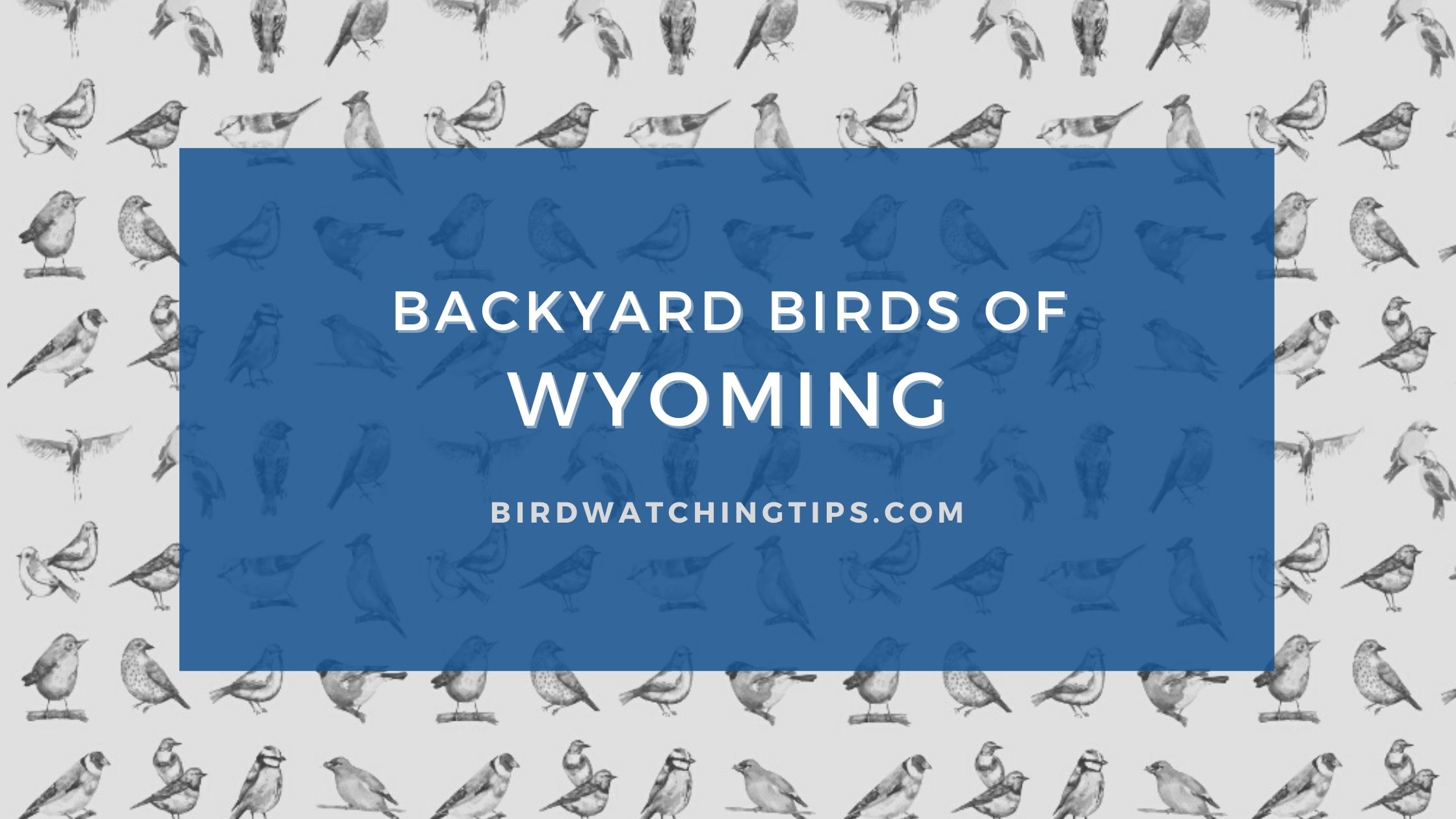The ‘Equality State and also known as the ‘Cowboy State’ of Wyoming is located in the mountainous west of the United States and for those who love nature, the fact that is also the least populous state has a lot of appeal. Less crowding and more nature is definitely a recipe for some serious birdwatching and today we are going to talk about the popular backyard birds of Wyoming so that you can get a taste of what birding in the Cowboy State is really like. Let’s talk about birding in Big Wyoming!
3 Categories – 444 Birds
It might not surprise you to hear that over 44 species call Wyoming their home at various times of the year. While we obviously can’t chronicle all of them here in this article, we can certainly give you a modest sampling which we will divide up seasonally like this:
- Year-round Resident birds
- Birds of Spring, Summer, and Early Fall
- Fall and Winter Birds
We’ll let you know where these birds like to hide, what they like to eat, and how you can quickly identify them. With a little luck and a well-stocked feeder, they may even come to your backyard for a visit! We’ll get started with Wyoming’s year-round resident birds.
Wyoming’s Year-round Resident birds
The birds in this category may be seen at any time of year in the great state of Wyoming and we’ve got a good sampling for you. See if you can spot one of these birds this year:
- Eurasian Collared Dove
- American Robin
- Downy Woodpecker
- Red-breasted Nuthatch
- European Starling
Eurasian Collared Dove – Streptopelia decaocto
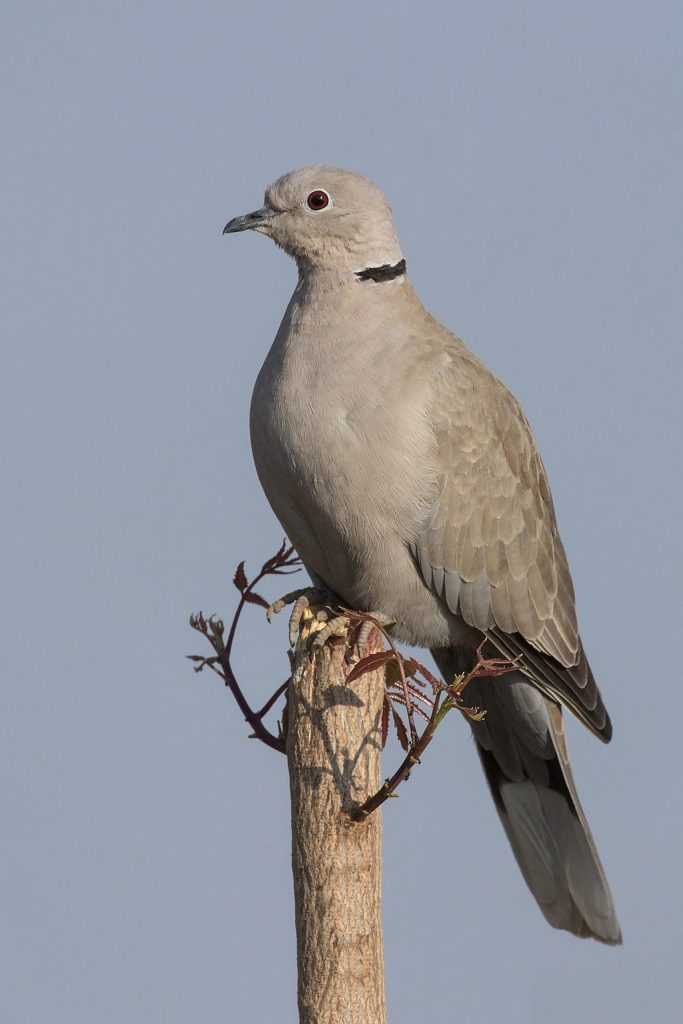
Coloration and Markings: Eurasian Collared Doves have light brown to buffy-gray backs, with broad, medium length wings and long tails of the same color. Some grayish black may be seen towards the tips of the wings and the tail and the underbelly and breast of this bird tend to be a slightly lighter buffy-gray. Facially, these birds will be the same colors, with the front of the face being lighter and a thin, white eyering will be visible. These Doves have distinctively ling necks and a black crescent mark wraps around about halfway down the neck and sometimes shows a little white around it. These birds have straight, medium-length black bills with a slight curvature visible on the upper bill.
Size: These birds measure in at 11.4 – 11.8 inches in length and have wingspans approximately 13.8 inches wide.
Habitat: These Doves are mostly acclimated to the city, where you might find them perched on fences, phone lines, or in nearby trees. You can find them at farms as well, hoping to get a little bit of the grain that is being put out for the livestock.
Diet: Millet, milo, cracked corn, and wheat are all favorites of this Dove and a little in your feeder will go a long way towards getting this bird’s attention.
American Robin – Turdus migratorius
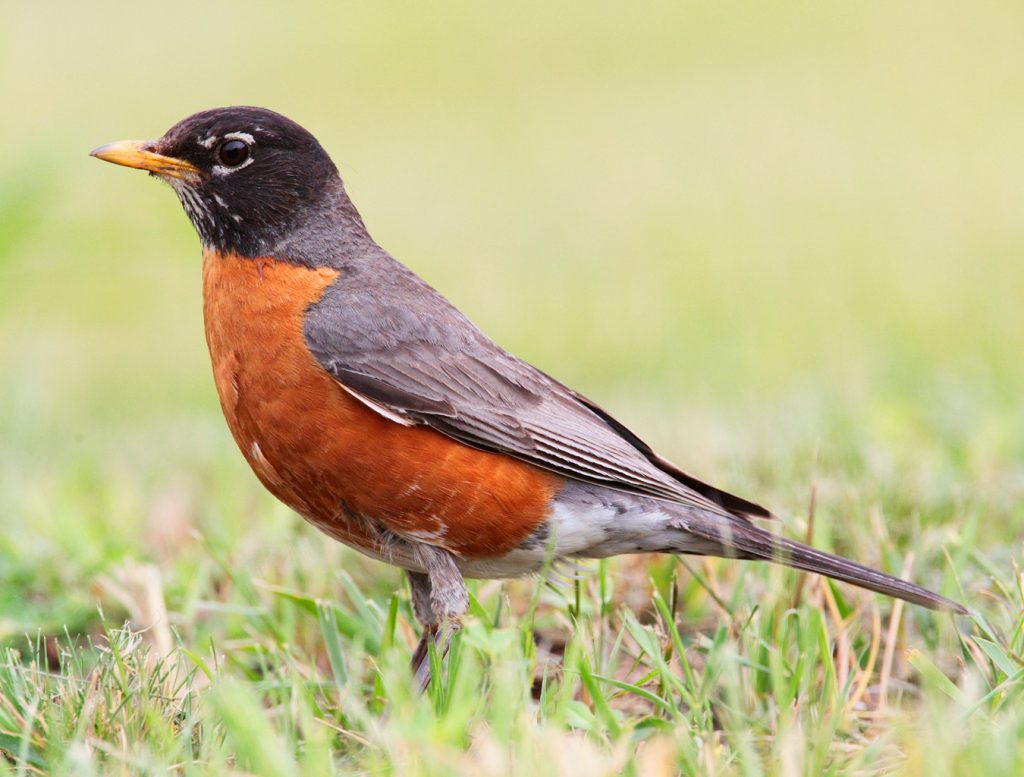
Coloration and Markings: American Robins have brownish-gray backs with medium-length wings and long tails of the same color, though you will notice white on the underside of the tail coming from the rump. The underbelly and breast of this bird, by contrast, will be a lovely reddish-orange color. Facially, these birds have black heads with distinctive white eyerings that look rather like they have been dropped, cracked, and put back on! Robins have medium length, slightly curved yellow bills with a tiny spot of black sometimes present at the tip of the bill. Female Robins will look much the, but with paler colored heads.
Size: These birds measure in at 7.9 – 11 inches from tip to tail and have wingspans of 12.2 to 15.8 inches wide.
Habitat: Adaptive little beauties, American Robins may be found in many different environs, such as Pine forests, tundra, pastures, golf courses, parks, or in backyards with well-stocked feeders.
Diet: Robins love raisins, suet, crushed peanuts, and just about any fruit that you have around the house. Be sure to leave a little something out for them, as you’ll really enjoy getting a closer look at the American Robin.
Downy Woodpecker – Picoides pubescens
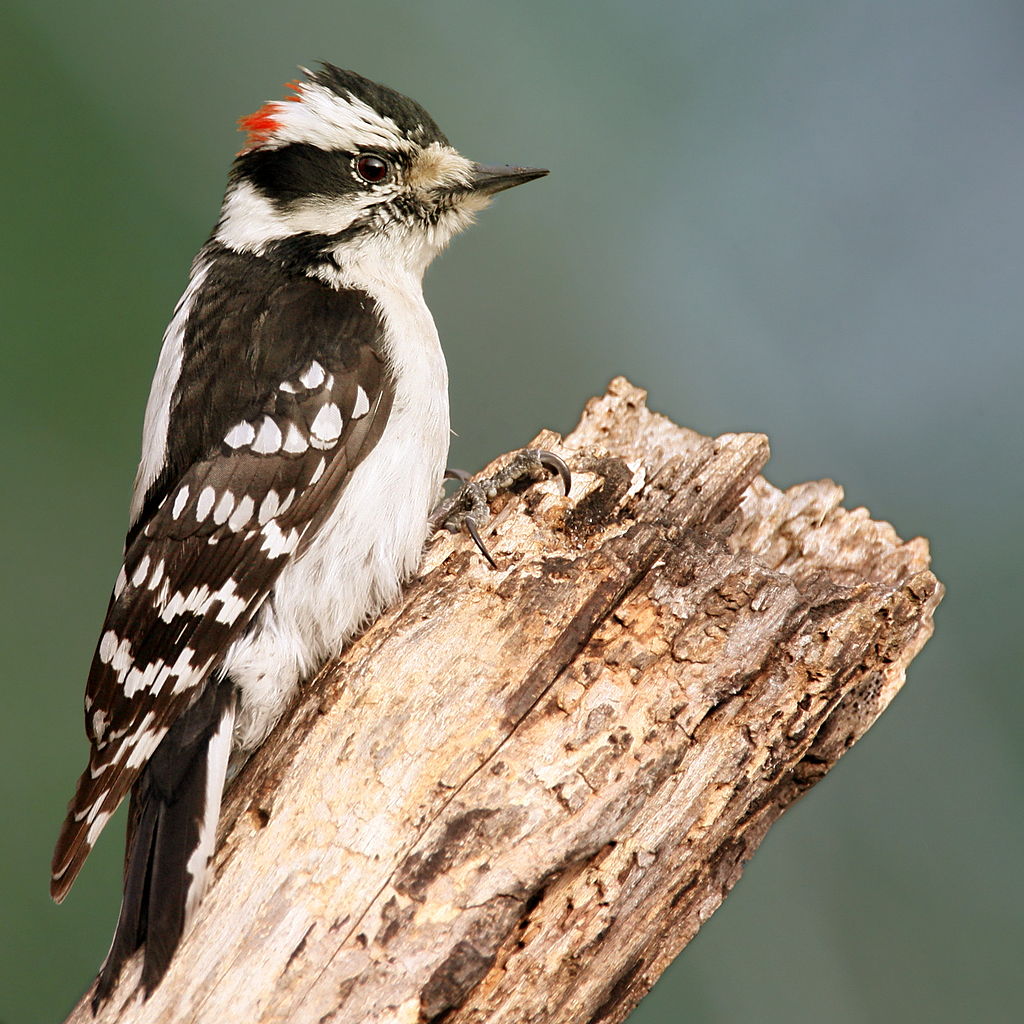
Coloration and Markings: Downy Woodpeckers have a broad, white stripe on their back and medium-length black wings with a checkerboard pattern of white squares which starts just below the shoulders and moves across the wings like little checker-stripes. They have short, notched tails which are black with white underneath and the breast and underbelly of this bird are a snowy white as well. Facially, this Woodpecker has a white face with a black mustaches line, a black ‘bandit style’ mask, and a thin, black cap which turns red just above the mask if you are looking at a male. These birds have straight, thin, and medium-length black bills.
Size: The smallest North American Woodpecker, Downies measure in at 5.5 – 6.7 inches in length and have wingspans of 9.8 to 11.8 inches wide.
Habitat: Downy Woodpeckers love deciduous woods but may be found in just about any open woodland where there is a good density of brush and weeds. They do range out quite a bit, spending time in orchards, parks, and backyards where they have made to feel welcome.
Diet: These birds love a number of foods, so you may attract them with suet, cracked corn, peanuts, and they definitely have a sweet tooth, so leave a little fruit out if you’ve got some. Half an orange will do quite nicely and don’t be surprised if you see one taking a sip out of your hummingbird feeder. These birds love the sweet stuff!
Red-breasted Nuthatch – Sitta canadensis
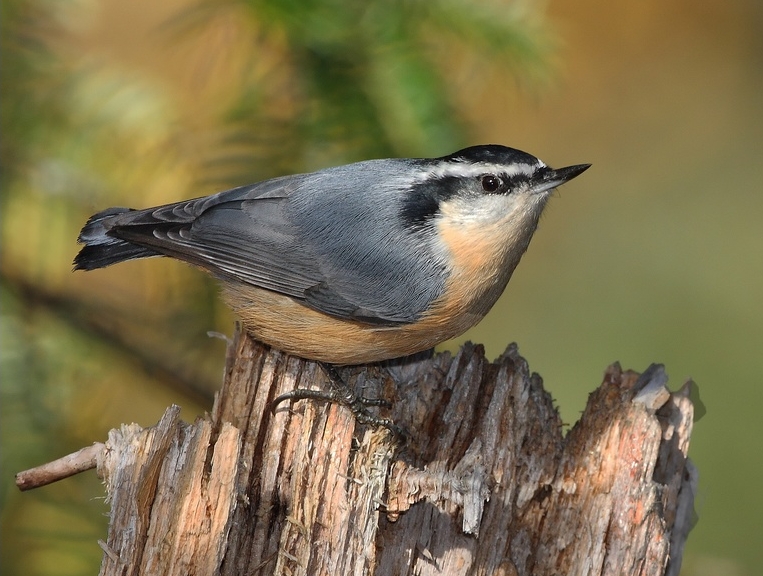
Coloration and Markings: Red-breasted Nuthatches have gray and blue backs, with short wings and tails, with a little darker gray at the wing and tailtips. The underbelly and breast of this bird are a smooth, cinnamon color, which carries up into the face to triangulate at the point just below the bird’s bill. Facially, these birds have a mix of white, gray, and light blue at the cheeks, with a black eyestripe that curves down to the nape of the neck and a black cap which does the same. These birds have long, straight black bills, with some lighter coloration and slight upper curvature present on the lower portion of the bill. Females will be slightly paler at the breast and underbelly.
Size: These perky little guys and gals measure in at an average of 4.3 inches long and have wingspans of 7.1 to 7.9 inches wide.
Habitat: These are mostly mountain birds and they prefer coniferous forests, spending a lot of time around fir, pine, and spruce trees. You can also find them in deciduous woods, however, where they like to spend their time around oaks, birch, maple, and hickory trees.
Diet: Peanut butter, crushed peanuts, Black Oil Sunflower seeds, and suet are all favorites of the Red-breasted Nuthatch that you can use to lure them in so that you can get a closer look.
European Starling – Sturnus vulgaris
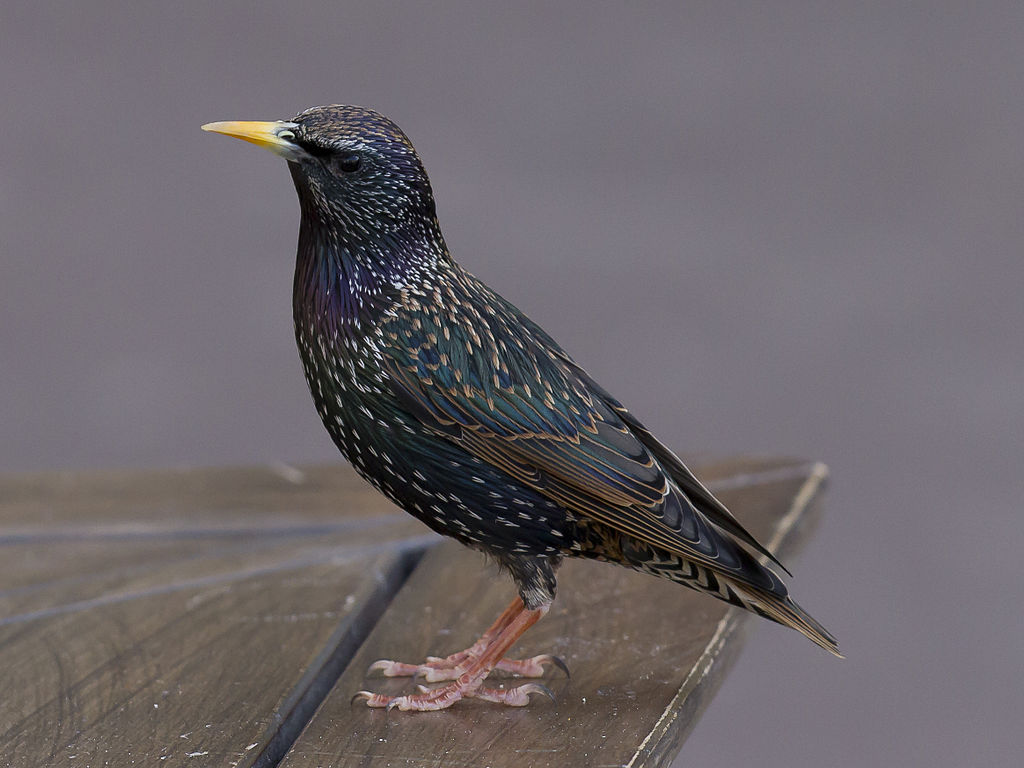
Coloration and Markings: European Starlings may look like yellow-billed Blackbirds from a distance, but up close you can see their true colors. These birds have shiny green and purple coloration all over their bodies in the warmer months. They have long, powerful wings and rather short tails and facially, they have long, straight yellow bills. In the winter, these birds doff their shiny, dark coats and replace them with a lovely brown plumage which is covered with white spots!
Size: These birds measure in at 7.9 – 9.1 inches in length and have wingspans of 12.2 to 15.8 inches wide.
Habitat: These are city birds to their core, with their origin in the United States being that they were brought to New York from Europe by Shakespeare fans! As such, you probably won’t see them in the woods but you can find European Starlings just about anywhere in the city. They do visit farms from time to time as well, where they are sometimes considered a bit of the nuisance as these smart birds can easily get into the grain stores.
Diet: Starlings love suet, so much that you might want to add Starling-proof covers to one of your suet feeders so that there will be a little for the other birds! They do also like wheat, rolled outs, Black Oil Sunflower seeds, and White Proso millet so even if you lock up the suet you can still leave a little something out for them which they’ll happy to munch on.
Wyoming’s Birds of Spring, Summer, and Early Fall
Winter has a little more pull in some areas and people in Wyoming joke that the first sign of spring is a snowstorm. Snowdrops and daffodils, however, are a much better indicator, and you’ll also hearing the frogs, seeing bumblebees, and of course the influx of Avian arrivals. See if you can spot one of these birds during the warming-up and warmer months in Wyoming:
- Yellow-headed Blackbird
- Western Tanager
- Eastern Bluebird
- Violet-green Swallow
- Purple Martin
Yellow-headed Blackbird – Xanthocephalus xanthocephalus
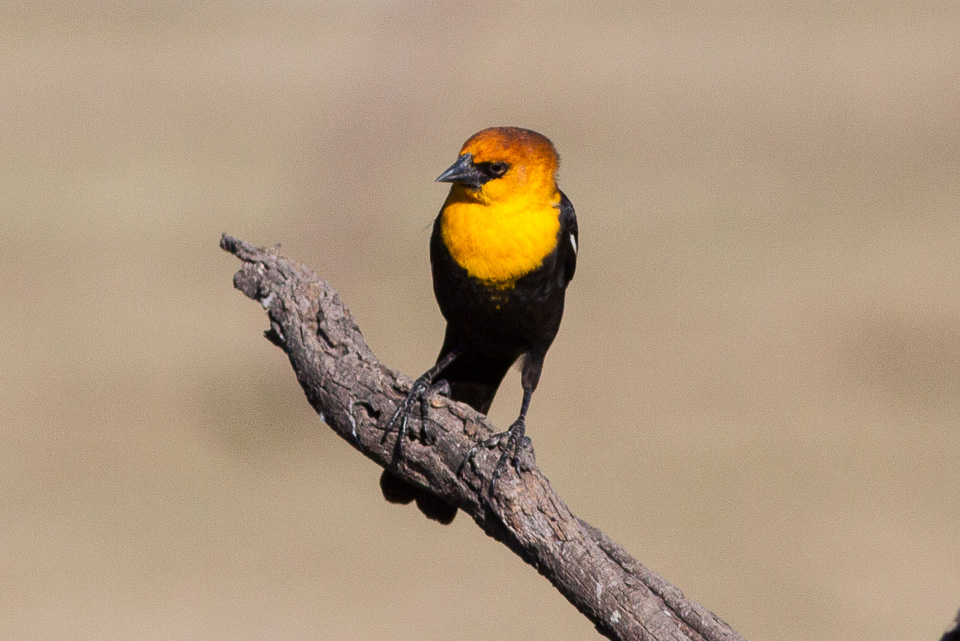
Coloration and Markings: Yellow-headed Blackbirds are quite the sight to see, with their black backs, long, black wings with white patches at the edge of their wings under the shoulders, and their long, black tails. While the underbelly and breast of this bird are black as well, when you get to the head and the neck this bird looks as if it has on a yellow, rubber hood! The yellow triangulates down into the breast and covers the head, with the exception of a diamond-shaped black mask and the bird’s long, straight, and pointy black bill. Sometimes the yellow may be a little less pronounced in the males but it is definitely visible. In juveniles and females, the plumage tends to be more of a brownish color, and the females will lack the white markings at the bend of their wings while juveniles will show a slightly diminished version. Their yellow color will also not be as shiny and bright as the full-grown males.
Size: These birds measure in at 8.3 – 10.2 inches from head to tail and have wingspans of 16.5 to 17.3 inches wide.
Habitat: These birds love fields and wetlands, spending a lot of time in the former when it is cold outside.
Diet: Black Oil Sunflower seeds and any grains that you have available may attract and possibly keep the attentions of the Yellow-headed Blackbird.
Western Tanager – Piranga ludoviciana
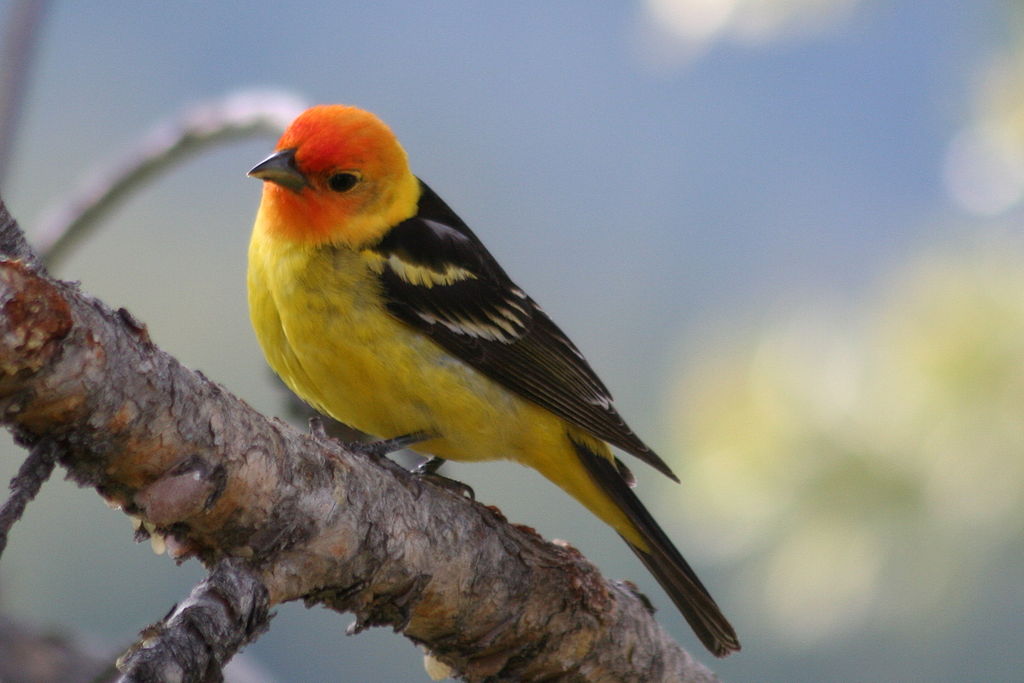
Coloration and Markings: Male Western Tanagers have backs which are a mix of yellows and blacks with some pure light yellow see as you look lower towards the tail. They have medium-length black wings with two wingbars, the upper one being yellow and a longer, white wingbar below. They have medium-length black tails with some yellow underneath coming from the rump and the underbelly and breast of this bird are light yellow as well. While the back of the head is yellow, the rest of the face and throat will have reds mixed in on the males and their stout bills are brown or a dirty yellow and have a slight curvature to them. Adult females will be more of a yellowish-green color and will only have red in the fronts of their faces, while juveniles will be most apparent in the spring, showing the least amount of red in their faces.
Size: These birds measure in at 6.3 – 7.5 inches in length and have wingspans of approximately 11.5 inches in width.
Habitat: These Tanagers love to spend the warm months in coniferous woods, but they don’t seem to have specific favorites. Junipers, spruce, firs, and pines are all potential hosts for these brightly-colored beauties. When it gets colder, however, they tend to range and are more likely to be found in woods with a high density of oak and pine.
Diet: Fresh fruit and berries are the best way to attract Western Tanagers into your backyard. Try leaving out an orange half, chopped cherries, or even dried blueberries and raisins. These birds really love fruits and you might just make a new friend.
Eastern Bluebird – Sialia sialis
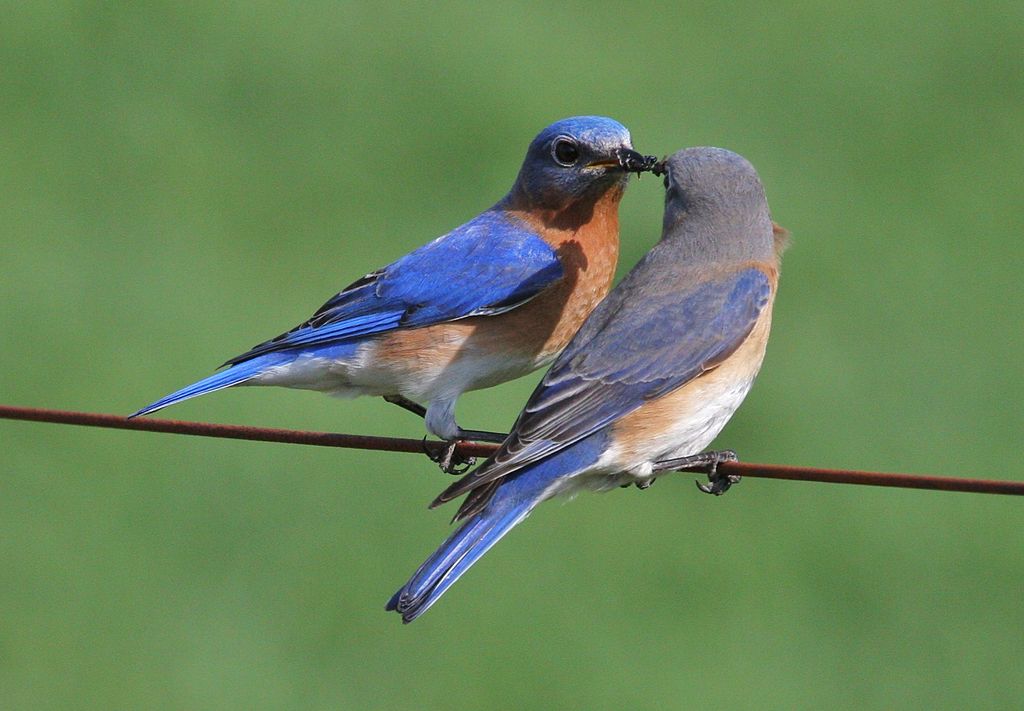
Coloration and Markings: Male Eastern Bluebirds are plump and pretty, with short and striking blue wings which have a minute amount of black at the wingtips and tiny blue tails which sport a little black edging. They have white rumps and underbellies with a heavy flanking of cinnamon-orange coloration starting from the sides of the underbelly and thickening at the breast, where this color continues upwards to the base of the throat, extending to the back of the head. Facially, this bird is blue with a thin, slightly curved silver bill. Females will be mostly gray, by contrast, with some blue in their wings and much lighter cinnamon color at the breast and flanking the underbelly.
Size: These birds measure in at 6.3 – 8.3 inches from head to tail and have wingspans which are 9.8 to 12.6 inches wide.
Habitat: Bluebirds love open meadows and tend to nest in knotholes if they can find ones that are big enough. A nesting box in your backyard might even lure one to you, so this is well worth considering. They make great backyard companions!
Diet: These birds love mealworms, suet, raisins, and broken-up Sunflower seeds of any variety.
Violet-green Swallow – Tachycineta thalassina
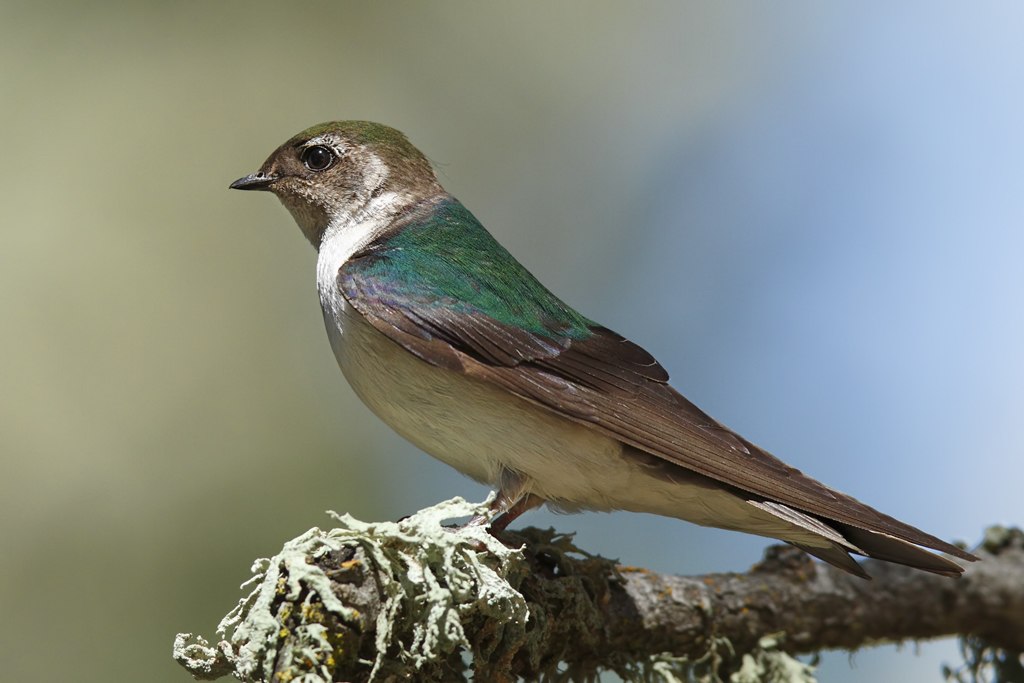
Coloration and Markings: Violet-green Swallows are quite amazing up close. With backs of bronze-tinged green and rumps and purples and blues as the color goes further down, framed at the sides with long wings of gray, which carry the bronze and green at the shoulder. They have short, notched gray tails and the underbelly and breast of this bird are a bright, paper-white that carries up into the face where it squares off and terminates just above the eyes. The top of this bird’s head is back to green and you’ll see a tuft of gray just in front of the eyes. These birds have tiny, lightly curved black bills. Females and young males will have darker cheeks and juvenile Violet-green Swallows will be grayish-brown, rather than green and bronze, on their backs and at the tops of their heads.
Size: These little birds measure in at approximately 4.6 inches in length and have wingspans averaging about 10.6 inches wide.
Habitat: Violet-green Swallows like many kinds of open woods and you can find them in deciduous forests, evergreens woodlands, or even mixed woods. Looks for larges holes in trees as this is where they like to nest. They are also quite fond of water, so your chances of spotting one can go up if there is a river, lake, or a stream nearby.
Diet: Strictly insectivores, these birds like to catch their food in-flight. While you might have some luck with live mealworms in your feeder we can’t make any guarantees that it will lure this bird.
Purple Martin – Progne subis
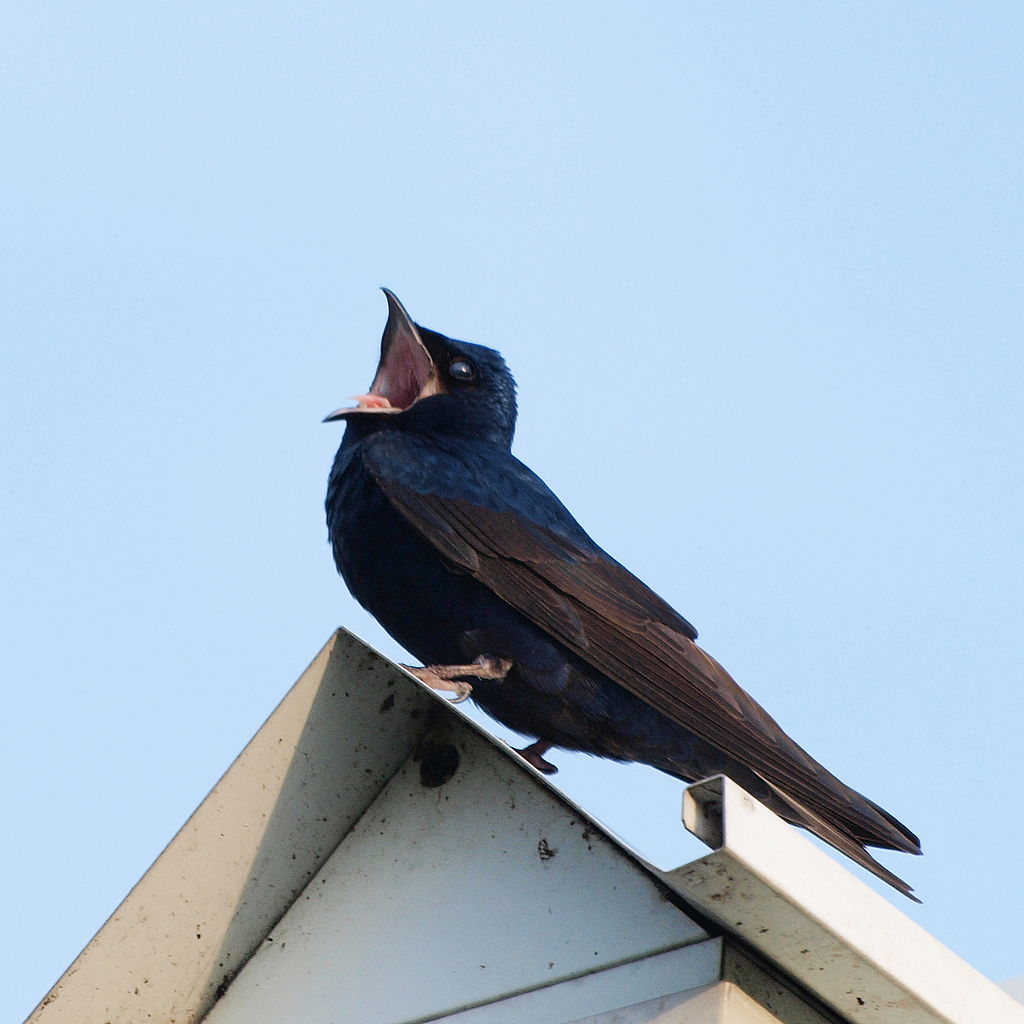
Coloration and Markings: Purple Martins are sharp looking birds, with dark bluish-purple plumage on their backs, spotted with brownish-black, and extending onto the shoulders of their long brownish-black wings. These wings are tapered and these birds also have short, forked tails. The underbelly and breast of this bird are bluish-purple with the brownish-black spots, and overall it gives a rather ‘scaled’ look to this bird. Facially, we have more of the same color, with a striking exception of a diamond-shaped mask in front of the bird’s short, stout, and slightly curved black bill. Females and juveniles tend to have lighter bellies, even whitish in many cases, and will have less brownish-black on their chest and on their head.
Size: These birds measure in at 7.5 – 7.9 inches in length and have wingspans of 15.3 to 16.1 inches wide.
Habitat: These birds love open woods, especially with water nearby, and preferably with natural cavities in the area to nest in. They are attracted to nesting boxes, often in large numbers, and even nest in Woodpecker holes.
Diet: Purple Martins are only interested in flying insects, though when it’s breeding season they will sometimes come to feeders to eat crushed eggshells, which are thought to aid in digestion. Give this a try and see if you can get the Purple Martin’s attentions!
Wyoming’s Fall and Winter Birds
Wyoming winters don’t mess around, with temperatures ranging between 0 and 18 degrees Fahrenheit, depending on your location in this state. Despite these serious temperatures, a number of tough birds are still out there foraging, so be sure to consider setting up a heated birdbath for the following ‘birds of steel’ and their relatives out there in the cold:
- Black-capped Chickadee
- Lapland Longspur
- House Sparrow
- Northern Flicker
- House Finch
Black-capped Chickadee – Poecile atricapillus
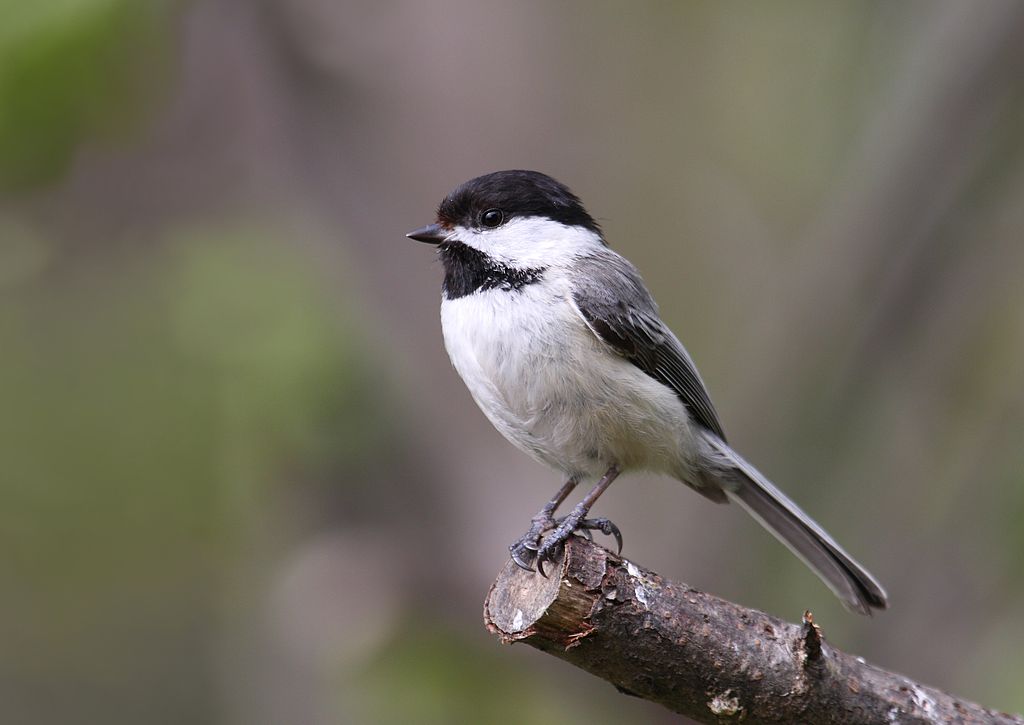
Coloration and Markings: Black-capped Chickadees have gray backs with short, gray, and white-edged wings as well as long, dark gray tails with some white edging there too. Their underbelly and breast are a snowy white, with a flanking of buffy-tan coloration, and facially these birds have small, black bibs, with a white stripe starting from the bill that crosses the cheeks and goes to the back of the head. Finally, this bird hasa large, black cap that terminates at mid-eye level. These birds have small, triangular black bills.
Size: These birds measure in at 4.7 – 5.9 inches from head to tail and have wingspans of 6.3 to 8.3 inches wide.
Habitat: While these birds do love forests of any kind, they are also quite urbanized, spending a lot of their time in parks and in backyards with well-stocked feeders. You can also find them where water is close, perched on cattails in a marsh or taking advantage of shrub cover for a little streamside foraging.
Diet: Suet mixed with peanut butter is a favorite of the Black-capped Chickadee but they also go for Black Oil Sunflower seeds, raisins, and whatever berries that you have on hand.
Lapland Longspur – Calcarius lapponicus

Coloration and Markings: Lapland Longspurs have a back that is a mottled mix of browns outlined in whites. They have medium-length wings and short tails of the same color, with the tails being white on the undersides. The underbelly and breast of this bird are white, with some black streaking present at the sides, and facially this bird has a very distinctive black face and neck, with a rufous red mark present at the back of the head at the bottom and white coloration between this and the black, outlining the throat, cheeks, and curving over the eyes. These birds have black caps and strong, medium length yellow bills. Females will lack the black, being lighter in color and displaying 2 very thin white wingbars. In the winter, both genders will retain dim versions of their facial coloring but their plumage becomes brown, with their tails displaying some white edging to go with that brown.
Size: These birds measure in at 5.9 – 6.3 inches in length and have wingspans of 8.7 to 11.4 inches wide.
Habitat: These birds love open areas and thrive in the cold, so look for them in sand dunes by the coast, fields, or turf farms when it’s chilly. Look down, though, as these birds like to forage on the ground.
Diet: While these birds east a lot of insects, they do like small seeds as well, so you might have some luck with a ground feeder with some Nyjer Thistle and White Proso millet to get their attentions.
House Sparrow – Passer domesticus

Coloration and Markings: Male House Sparrows have rich brown backs with black streaking, as well as small wings and tails of the same color. Underneath the tail the coloration will be a little lighter and the underbelly and breast of this bird are a dusky gray. Facially, these birds have white cheeks and black bibs that carry down into the breast, as well as an eyestripe that starts black in front of the eyes and becomes a rich brown as it passes through, going all the way to the back of the head and curling around to frame the cheeks. The top of this birds head is a somber gray and it has a medium-length, stout black bill with a noticeable curve on the upper half.
Size: These birds measure in at 5.9 – 6.7 inches in length and have wingspans of 7.5 to 9.8 inches wide.
Habitat: These little birds are almost completely urbanized, though you might see them at farms raiding the livestock feeders. More often you’ll find them hanging around the city, looking for delicious handouts.
Diet: Cracked corn, rolled oats, and wheat are all delicious to the House Sparrow who will be more than happy to visit your feeder once they’ve noticed it.
Northern Flicker – Colaptes auratus
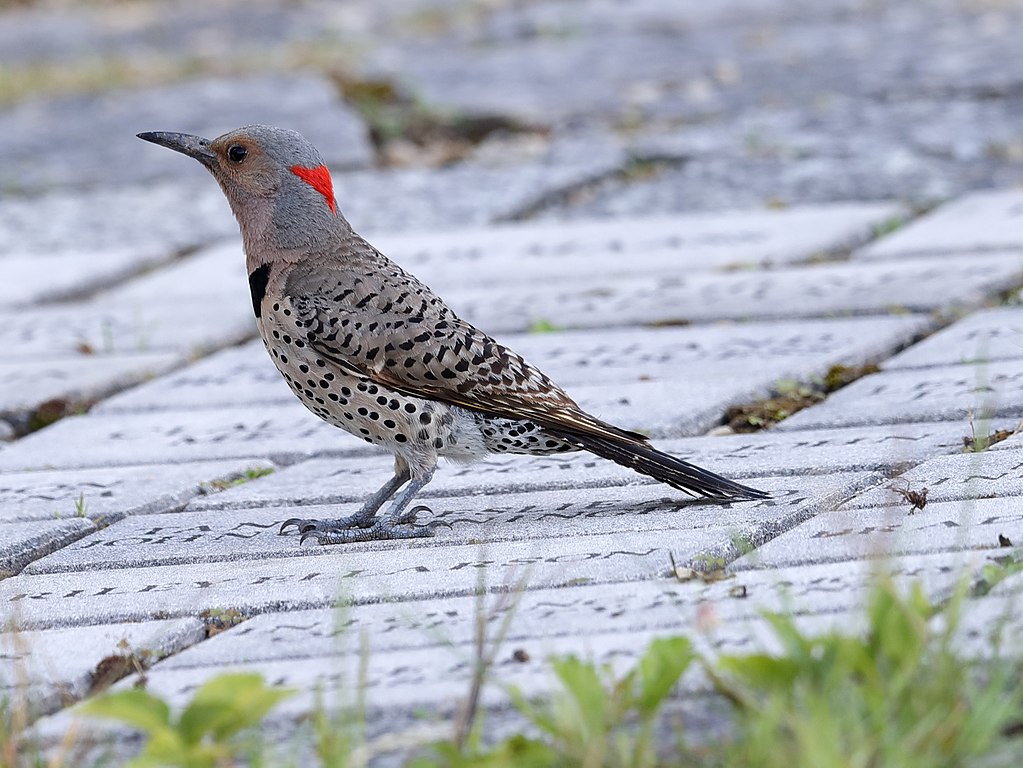
Coloration and Markings: Northern Flickers are stunning birds, with brownish backs covered in assorted crescent patterns. They have medium length wings displaying the same pattern and long, flared tails which are brown with crescents on top but underneath they will be black-tipped and either bright yellow or red (with yellow for eastern birds and red for the western ones). The underbelly and breast of this bird are brownish-gray with black spots and at the top of the breast, just under the gray neck of the bird, is an inverted crescent mark that you can’t miss. Facially, these birds are gray, with thin, white eyerings and a distinctive red stripe mark across the cheek. A light, buffy-brown eyeline is also present but tricky to spot. These bird have long, lightly curved silver bills.
Size: These Woodpeckers measure in at 11 – 12.2 inches from tip to tail and have wingspans of 16.5 to 20.1 inches wide.
Habitat: These birds love open areas, such as copses, meadows, and the forest’s edge. They are also fond of mountain forests and they have been known to visit the occasional backyard for snacks, so be sure to leave a little something out for the Northern Flicker.
Diet: Black Oil Sunflower seeds, suet, peanuts, and fresh fruits will have the best results when you are trying to lure a Northern Flicker in for a closer look.
House Finch – Haemorhous mexicanus
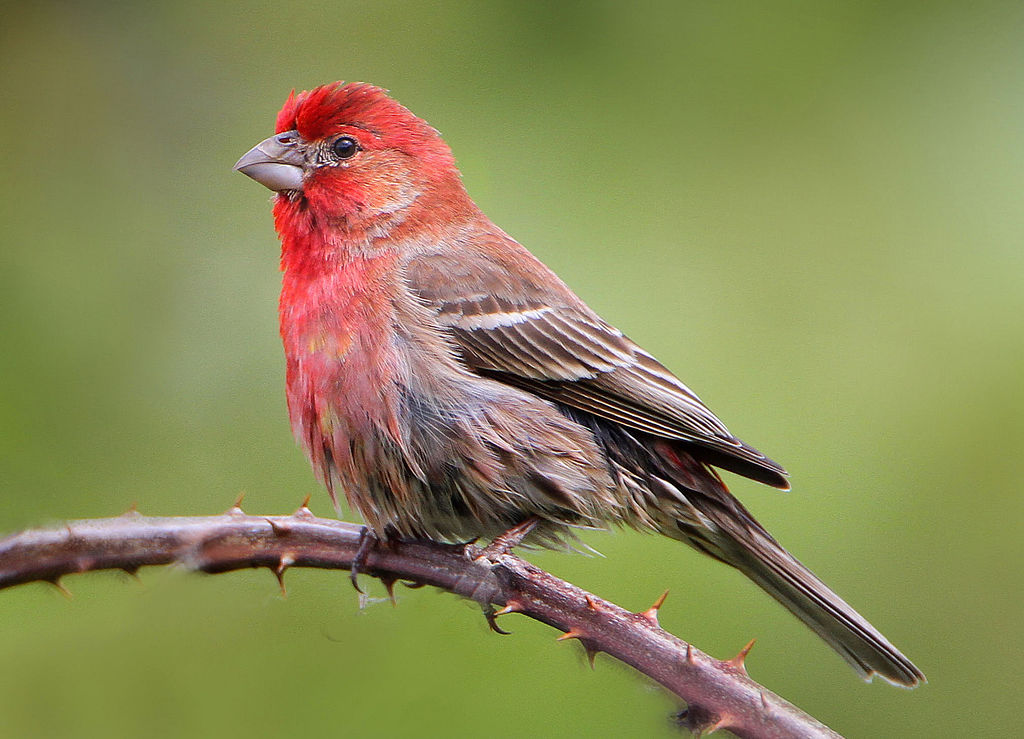
Coloration and Markings: House Finches have streaky brown or gray backs, with small wings with 2 white wingbars on each. The streaking looks almost like ordered stripe patterns on these wings and these birds have perky, medium length brownish-gray tails which are white at the edges. The underbelly of this bird is white with brown or black streaking but the breast will be a mix of white and a rosy-red that deepens as it carries up into the face. Aside from the red, which is heavy on the cheeks and the top of the head, male House Finches have a gray eyeline that travels through the eye and splits, with one line framing the cheek and the other moving towards the back of the neck. Some gray is usually peppered on the top of the head as well but this is minute. Female House Finches will lack the red color, being gray instead with their streaking lines a bit more blurry and without the distinctive facial markings of the male. These birds have stout, medium-length silver bills with some noticeable curvature to them.
Size: These birds measure in at 5.1 – 5.5 inches from head to tail and have wingspans of 7.9 to 9.8 inches wide.
Habitat: Found in a number of areas, House Finches can be spotted in desert chaparrals, open woods, the forest’s edge, farms, grasslands, or simply around the city. These little birds get around and they are more than happy to visit a feeder that has been stocked in advance for them.
Diet: Nyjer thistle, White Proso millet, and Black Oil Sunflower seeds (preferably broken up or small) are the way to the House Finches grateful little heart.
Supporting cast (Other Backyard Birds of Wyoming that might pay you a visit)
Our supporting cast birds are another set of year-round birds that you can keep an eye out for at any time of the year. While they didn’t make the front page of this article, these birds are definitely stars on their own and well worth looking out for. Be sure to leave a little something out in your feeder for one of these supporting cast birds:
- Rock Pigeon
- Mountain Chickadee
- Fox Sparrow
- Dark-eyed Junco
- Black Rosy-Finch
Rock Pigeon – Columba livia
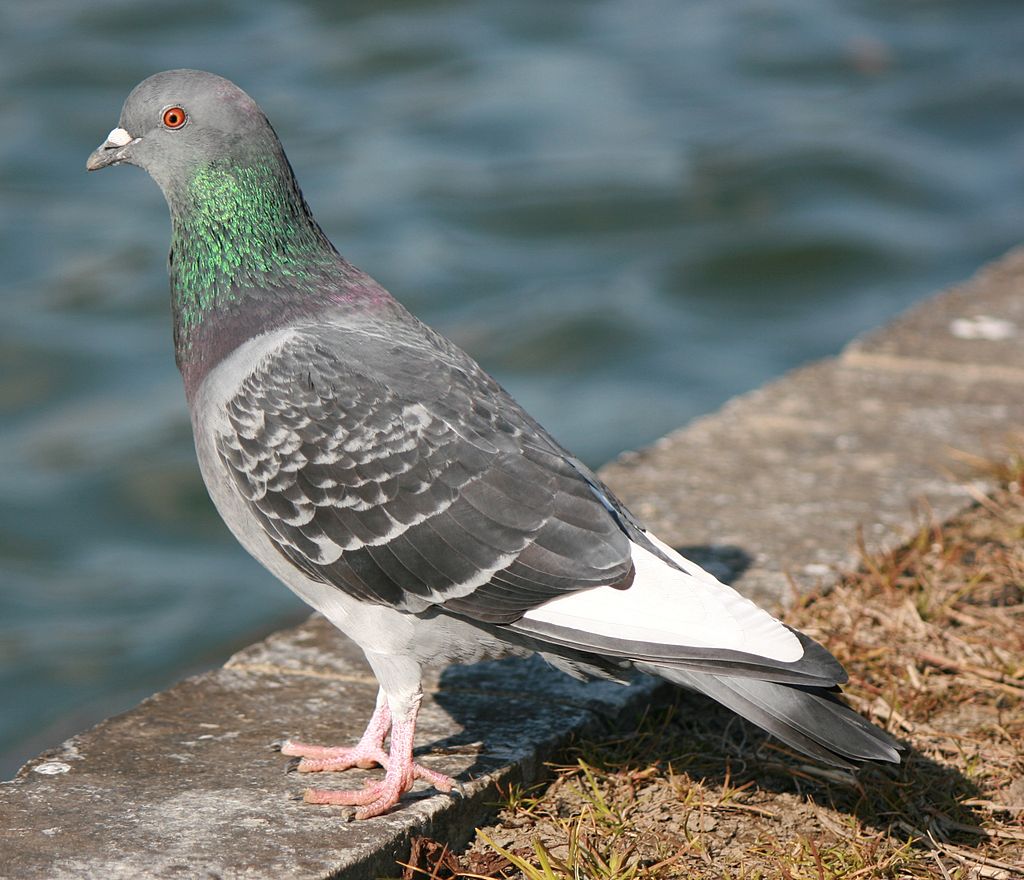
Coloration and Markings: Rock Pigeons have a little color variation but they are typically bluish gray or white, with long, broad, and pointy wings which may bear 2 black bands, dark spots, or no marks at all! They have short but wide, rounded tails and the underbelly and breast of this bird is generally gray or white. At the throat you will often see a mix of purples and greens and facially these birds are typically gray or white and often have a white line just behind their straight, medium-length bills. A slight curve will be visible on the upper bill.
Size: Good sized Pigeons, these birds measure in at 11.8 – 14.2 inches in length and have a wingspan of 19.7 to 26.4 inches wide.
Habitat: As their name suggests, these birds may be found making their homes in rocky cliff faces, but these Pigeons are practical foragers and are just as at home in the city, at farms, or in grassy, overgrown fields.
Diet: Seeds or grains of just about any kind are good for this bird, such as Nyjer thistle, Black Oil Sunflower, wheat, or rolled oats. They are easy to please and will happily visit your feeder once they know that it’s there.
Mountain Chickadee – Poecile gambeli
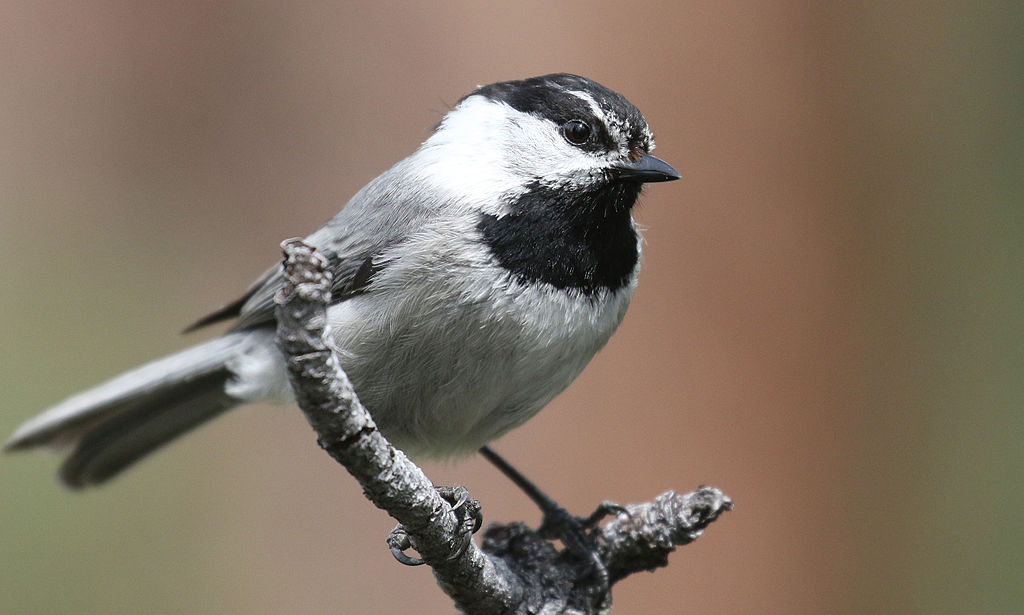
Coloration and Markings: Mountain Chickadees have soft gray backs, with small, pointed wings and medium-length perky tails which are also gray in color. They have a white breast and underbelly and facially, you will see a small, black bib, as well as a black cap and a mask. A white stripe above their mask is the biggest giveaway sign that you are looking at a Mountain Chickadee instead of another variety. These birds have straight, thin, medium-length black bills.
Size: These birds measure in at 4.3 – 5.5 inches from tip to tail and have wingspans of approximately 7.5 inches wide.
Habitat: These birds love the dry woods of the mountains, spending their days flitting about the evergreens as they forage.
Diet: These birds like suet and are especially fond of both crushed peanuts and peanut butter. Small seeds will also do in a pinch, such as Nyjer thistle and Black Oil Sunflower seeds.
Fox Sparrow – Passerella iliaca
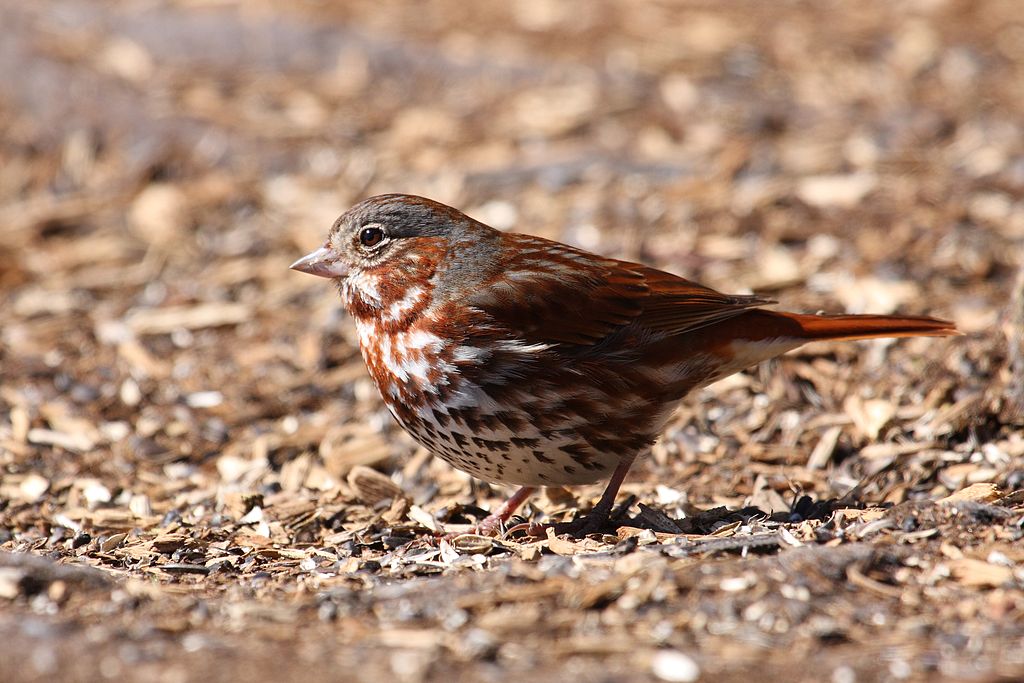
Coloration and Markings: While there are a lot of regional variances, Fox Sparrows will typically have rust/foxy red backs, with short wings that are mostly foxy red but will also contain a sprinkling of grays, and medium-length, perky tails which are foxy on top and snowy white underneath. The underbelly of this bird will be pure white flanked with rust-brown or foxy red sports and this spotted look becomes denser going up, taking up the center of the breast as well. Facially, this Sparrow’s head is mostly foxy-red, with a white mustache line, and a long, gray eyebrow line that goes to the back of the head, and circles around halfway around the base of the neck. The area underneath the mustache line and at the throat will be the same mix of spotted reds and whites that you see at the breast. These birds have stout, medium length, and conical yellow or yellowish-gray bills.
Size: These birds measure in at 5.9 – 7.5 inches from head to tail and have wingspans of 10.5 -11.4 inches in width.
Habitat: These bird love scrubs, brushes, and brambles, preferring to spend their time wherever the vegetation is thick, preferably in coniferous woodlands. During the winter they do a bit of ranging and you might just spot one at one of your ground feeders during this time.
Diet: Seeds and berries are the key to the Fox Sparrow’s heart, so try leaving a sampling of both, such as some Nyjer thistle and whole blueberries. You might just make an adorable new friend.
Dark-eyed Junco – Junco hyemalis

Coloration and Markings: Dark-eyed Juncos come in a number of color variartions, but the most commonly spotted variety will be a bird with a dark, brown or gray back, with medium-length brown or gray wings and a long, gray tail, which will be white on the undersides and has white, outer tailfeathers. The underbelly and breast of this bird are the white of powdery snow, with a flanking of gray or brown on the sides that increases in thickness as the color moves up to the breast. This makes an almost even division, resulting in a bird that is 1/3 white across the bottom when seen at rest, with the upper body being completely gray or brown. Facially, this bird has a stout, medium length pink bill.
Size: These birds measure in at 5.5 – 6.3 inches in length and have wingspans of 7.1 to 8.8 inches wide.
Habitat: Juncos love open areas inside coniferous and mixed-coniferous woodlands, though you can also find the overgrown fields, parks, backyards, or even roadsides.
Diet: Cracked corn, White Proso millet, and hulled Sunflower seeds of any variety can attract the attentions of a hungry Dark-eyed Junco.
Black Rosy-Finch – Leucosticte atrata
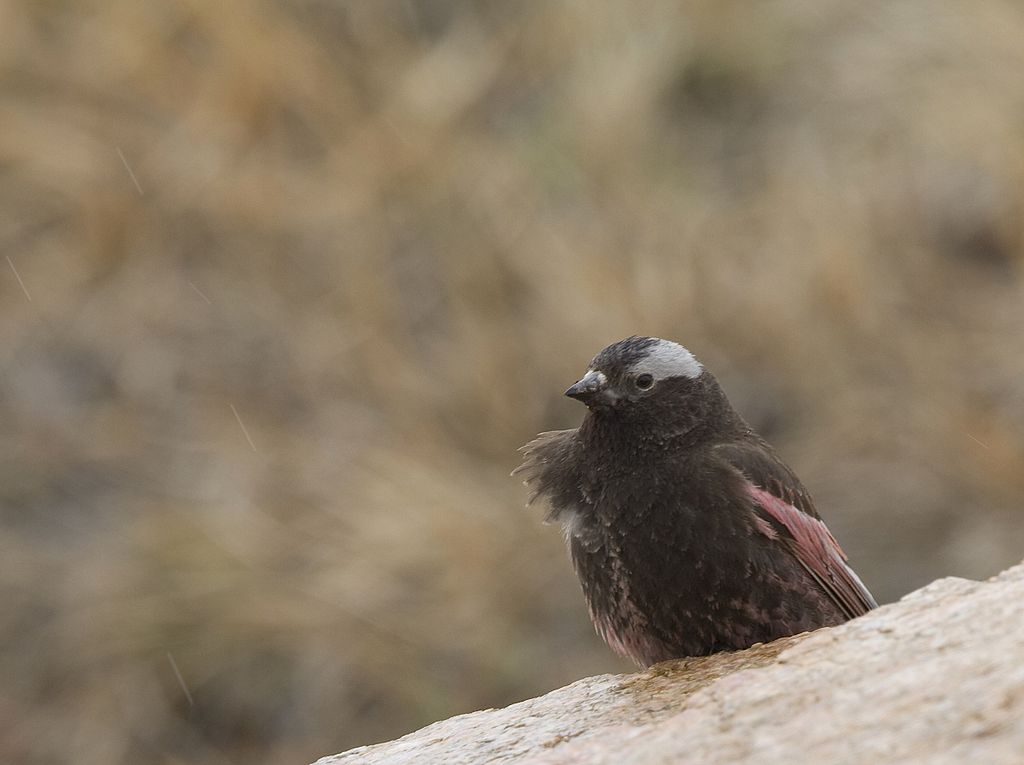
Coloration and Markings: During mating season, the Black Rosy-Finch has a black back, with long, black wings and a short, notched black tail. Traces of rosy red and pink will be seen on the wings, tail, and on the underbelly of this bird as well, with some spots of white around the rump. As the coloration moves up, the breast tends to be a more solid black and facially, this bird has a black face with a light gray eyestripe that goes to the back of the head and curves slightly downward. These birds have large, conical bills which will be black during mating season and yellow at other times. Non-breeding Rosy-Finches tend to be more brown than black, though you will see the tell-tale rosy hues in the plumage.
Size: These birds measure in at 5.5 – 6.3 inches from tip to tail and have wingspans of approcimately 13 inches wide.
Habitat: These birds love higher spaces than trees, spending a lot of time in cliffs or nesting in cavities of piled stones. In the winter, these birds range out and may be found in meadows at lower altitude, valleys, plains, and even deserts.
Diet: These birds eat a lot of insects, but you can also tempt them with small seeds such as Nyjer thistle or broken up or hulled, Black Oil Sunflower seeds.
Wyoming Bird Buffet
When you are setting up your feeder you simply can’t beat a little local advice and today we’re going to give you a sampling from a pdf by the University of Wyoming. It’s called “Feeding Birds In Your Backyard: A Great Way To Attract Wildlife” and we’ll give you some of their recommendations as well as a few of our own in order to help you in crafting that perfect feeder combination that gets you the best variety of local birds! If you’d like to read that pdf (and you should, it’s got feeder recipes!), be sure to check our reference links, but in the meantime try putting out one or more of the following foods to see if you have any luck:
- Black Oil Sunflower seeds
- German millet
- Cracked Corn
- Safflower seeds
- Nyjer thistle
- Oranges nailed to the trees
- Whole apples near the base of the feeders
Wyoming Birding Hot spots
The Chirparazzi are pros at weeding out the hiding polaces of Avian celebrities worldwide, and Wyoming is no exception to this rule. Today we’re sharing a few of the state’s hotspots, located at various compass points for your convenience. See if you can visit one of these sites to see your favorite feathered friends in the wild:
- Northern hotspot – Greybull Riverwalk
- Eastern hotspot – Douglas Bike Path
- Southern hotspot – Upland-Uinta Pathway
- Western hotspot – Jackson Hole Community Pathway System
- Central hotspot – Wyoming Heritage Trail
Detailed descriptions of each location as well as information regarding visiting and what birds you can see at these locations may be found at https://www.traillink.com/stateactivity/wy-birding-trails/
In Closing
We hope that you’ve enjoyed this little tour of Big Wyoming and it’s birding beauties. Birding in the Equality state is a very rewarding experience and even if you don’t live there, it’s well worth a week or two camping trip with the family if you want to spend a little time in nature. If you do go camping, we recommend that you bring a good camera because the chances are, you’ll be seeing a lot of beautiful birds here. Until next time, we wish you happy trails and happy sightings!
